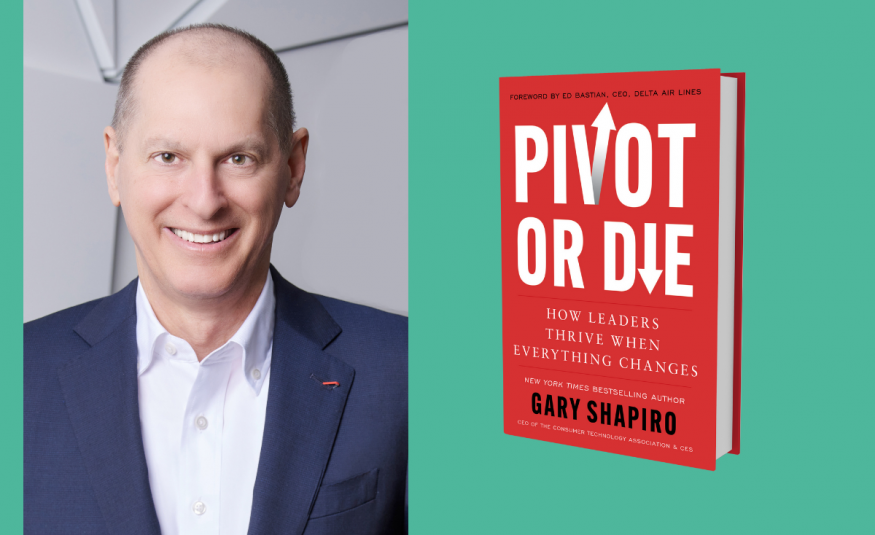Pivot or Die is the fourth book by Gary Shapiro, CEO of CTA, released in October. Stephanie Selesnick got her hands on a preview copy for review.
This book is a love letter to technology – how it has helped and will continue to help the human experience around the world. It’s also about leadership, filled with numerous examples of leaders who made significant decisions to pivot when faced with adversity and, surprisingly, success. Lastly, it’s somewhat autobiographical. CTA owns the United States' largest annual B2B exhibition, CES, held annually in Las Vegas.
I spoke with Gary about the book ahead of its official publication. He describes four kinds of pivots: The Start-Up, The Forced Pivot (when external factors change the environment in which a company operates), the Failure Pivot, and the Success Pivot. He explained that in 2011, Harvard Business Review dubbed ‘the pivot’ as “geek-speak for ‘this isn’t working: let’s change it up.’” The book states, “As a general rule, pivots foster innovation and creative thinking within an organisation. That’s especially true of forced pivots, where do-or-die situations foster an all-hands-on-deck mentality and reward out-of-the-box ideas.” It further elaborates: “Each type of pivot offers unique lessons on how to change your mindset as a leader and innovator and steer your business through challenging waters.”
Gary said: “Covid provided a lot of stimuli for innovation. We all learned online won’t replace face-to-face.” One could say it triggered the exhibition industry into a forced pivot. His favourite story in the book is about CES’s decision to pivot to a virtual show in 2021 – announced seven months before the event, based on science and common sense. “People thought we were crazy, but history has shown we made the right decisions – along with holding the show in person in 2022 during the Omicron wave.” That year’s show, despite media focus on large companies who didn’t attend, provided amazing opportunities for new companies and launches, particularly in the Eureka Park expo area, which features start-ups. In 2024, there were over 1,300 new companies in this section.
Gary believes that start-up culture is essential for all exhibitions: "It’s the path to entry into an industry – and it’s the right thing [for organisers] to do.” One of my favourite passages from the book relates to Start-Up Pivots: “We tell Eureka Park exhibitors to wear comfortable shoes and stay hydrated, but more importantly, we tell all our start-up entrepreneurs to be prepared to pivot based on feedback from visitors. Those who come only looking for investment – and not for advice – are less likely to succeed.”
Americans, more than perhaps any other culture, have come to embrace failure as a learning opportunity. In the Failure Pivot chapter, Gary shares an interesting story about how ‘Angry Birds’ (the popular video game and film franchise) was born out of the failure of another product. When leaders are adaptable and “don’t live in fear of failure,” pivots can happen, leading to success.
Looking to the future, no book on technology would be complete without a mention of AI. Gary sees AI as “horizontal”, meaning it cuts across every area and business within the tech industry. He advises, “What does this mean for business? If you’re not already thinking about how to integrate AI into your operations, you’re likely already behind. That doesn’t mean every product needs to put AI front and centre, but you should consider how AI tools can enhance productivity, strengthen customer relationships, and help your employees perform better. This is the age of the AI pivot, and working without it risks being left out of advances that are reshaping what’s possible.”
“‘Success pivoters’ are excited about change. They love a challenge. And, most of all, they’re visionaries – often even more so than those who implement other types of pivot. They’re able to see emerging trends, anticipate the future, and get out in front.”
Gary posits that a pivot doesn’t have to be a 180-degree turn; it may be incremental – 45 or 90 degrees – more of a course correction. “The value of a pivot built on prior success – rather than one prompted by failure or the fear of it – is the luxury of time, resources, and a deep knowledge base to invest in new areas of growth and opportunity.”
His advice for exhibitions is to ensure that your event provides a strong business case, along with third-party audits of your industry. For leaders, he advises, “Be yourself, honest, kind, praise publicly, chide privately, wear comfortable shoes, have empathy, and provide an outstanding customer experience.”
I found Pivot or Die to be an insightful read that encouraged me to reflect on how I approach and adapt to change. It’s worth the read.
This article is taken from EW Issue 5, to get the digital magazine bi-monthly to your inbox, subscribe here: https://www.exhibitionworld.co.uk/subscribe





